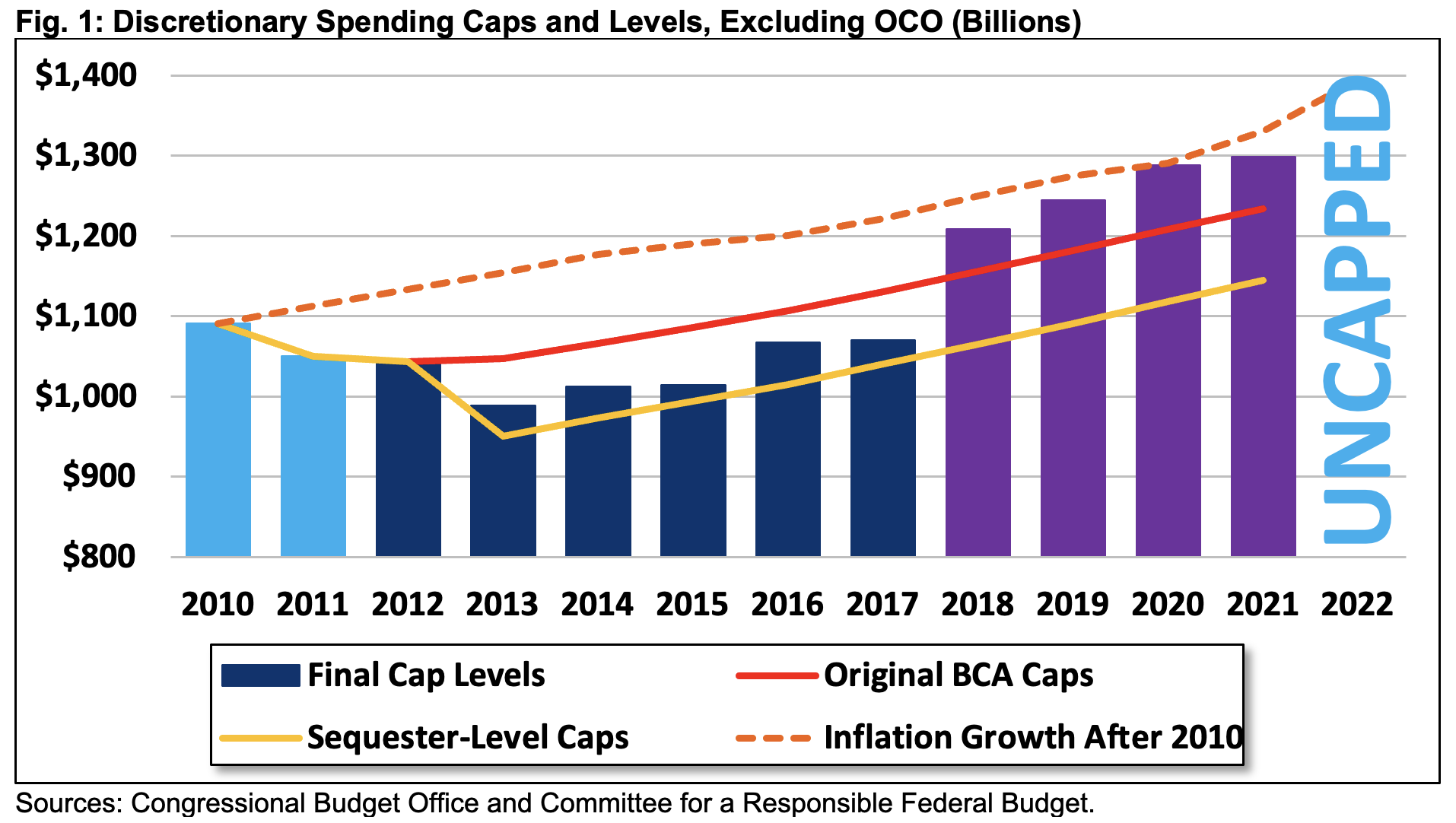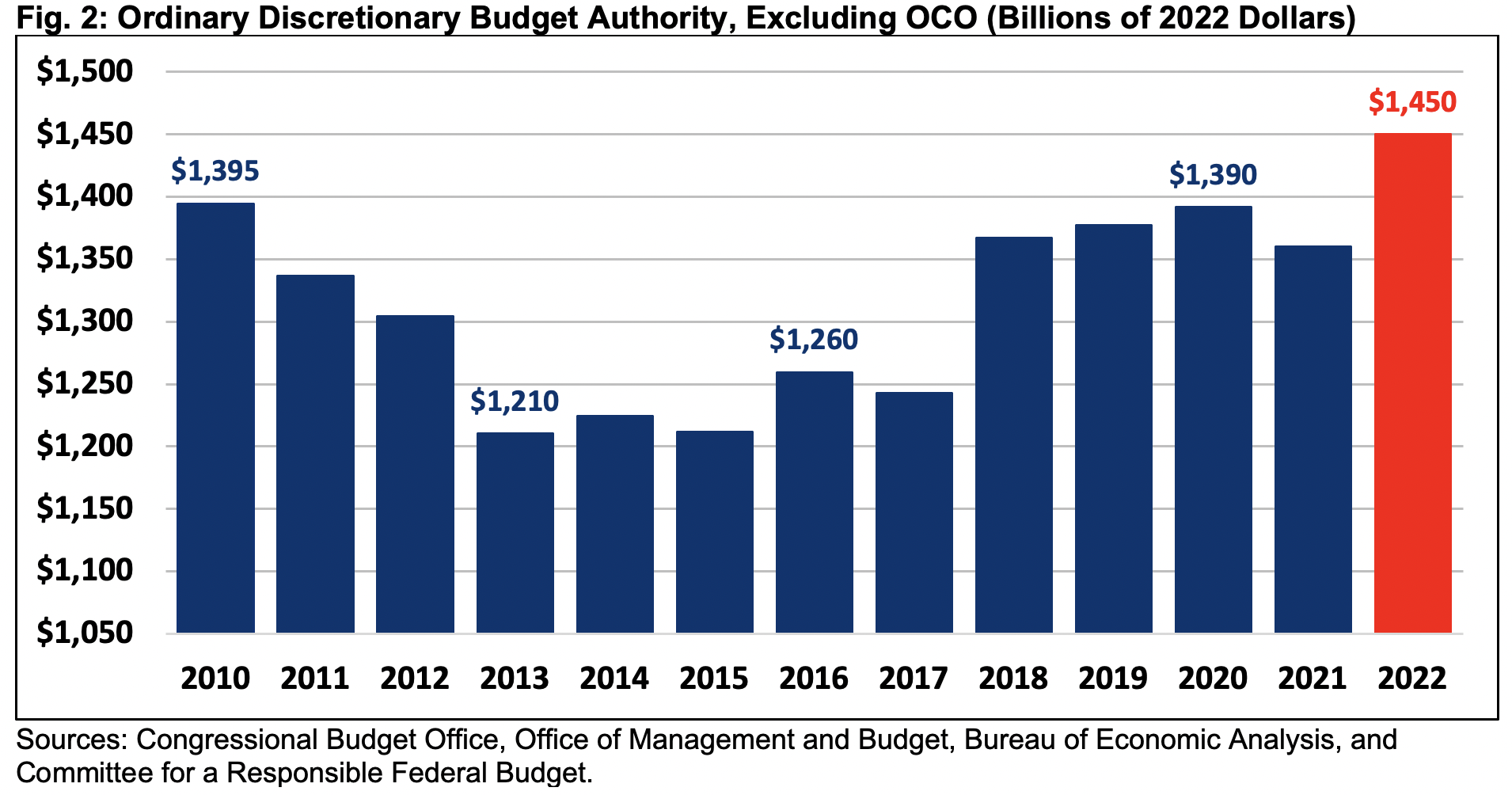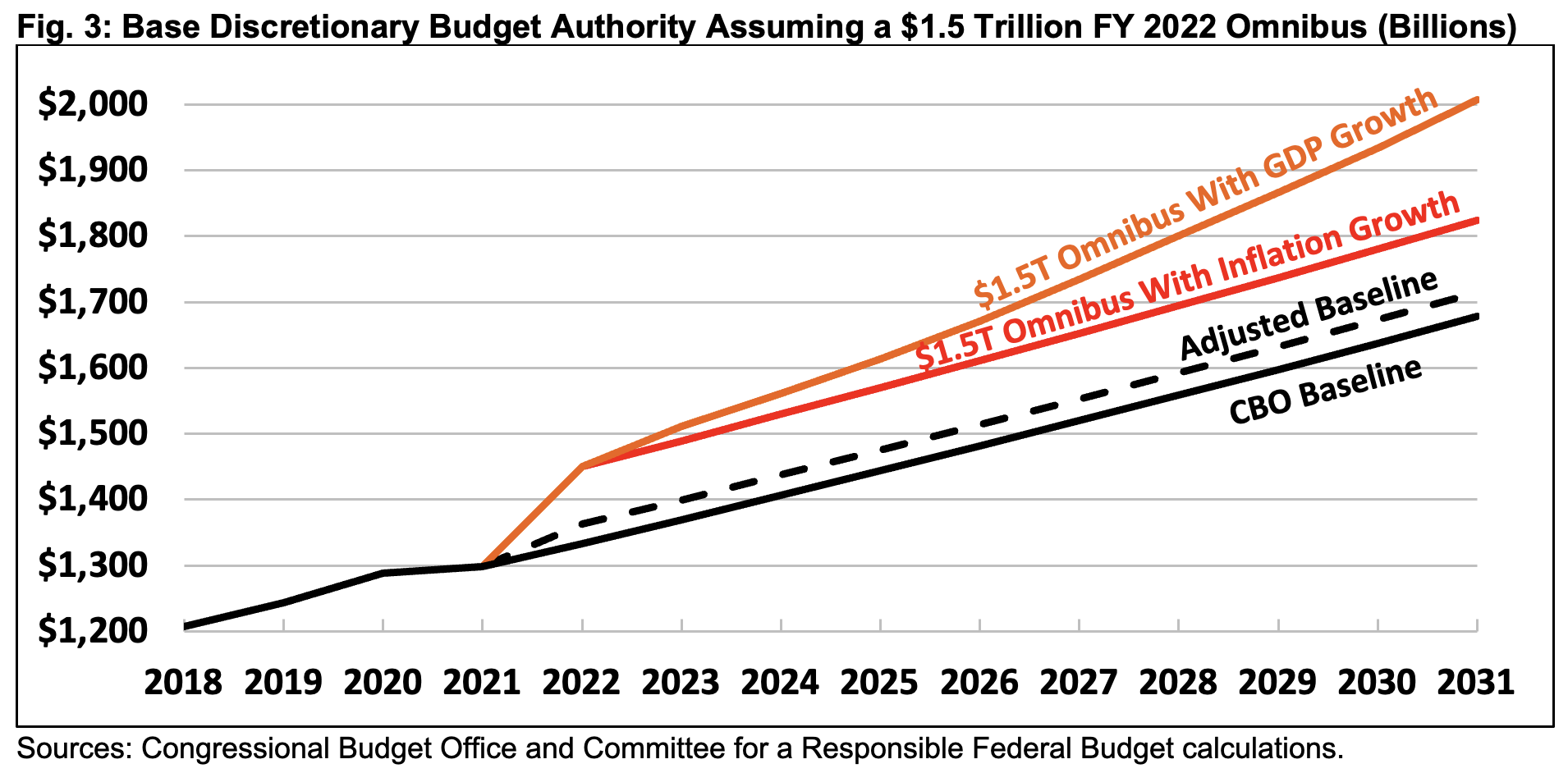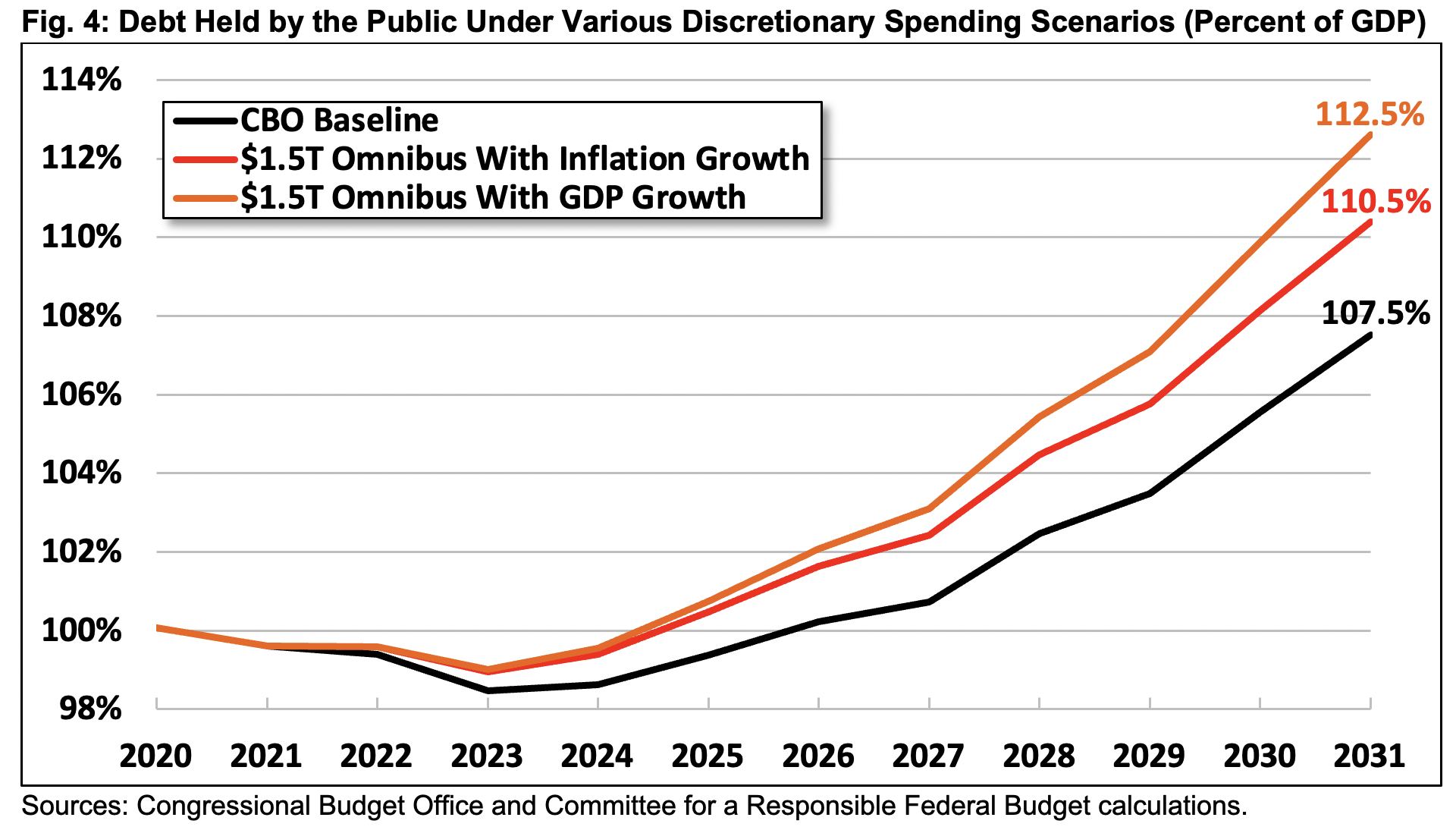The Case for Restoring Discretionary Spending Caps
On February 18, 2022, the current continuing resolution will expire, and legislation will be needed to continue funding the federal government. Unconstrained by the discretionary spending caps that were in effect between fiscal years 2012 and 2021, appropriators are currently pursuing a massive omnibus appropriations bill that would result in record spending levels and substantial new borrowing.
With inflation at a 40-year high and the national debt approaching record levels as a share of the economy, lawmakers should avoid large, deficit-financed expansions of the defense and nondefense discretionary budgets. Instead, lawmakers should chart a reasonable and responsible path for discretionary spending through a new multi-year cap regime that ideally saves money relative to current law. Any cost increases should be fully offset with mandatory spending reductions and/or new revenue.
In this analysis, we show that:
- Discretionary spending caps effectively limited appropriations through 2017. Between FY 2012 and 2021, discretionary spending levels were set based on the Budget Control Act of 2011, with modifications through various Bipartisan Budget Acts. While these caps were not perfect, they generally constrained the growth of defense and nondefense discretionary spending.
- Proposed FY 2022 appropriations would lift discretionary spending to historic levels. The House and Senate have proposed increasing ordinary discretionary spending by 9 percent relative to last year. If successful, FY 2022 base discretionary spending would be higher than any other time in recent history, adjusted for inflation.
- Adopting proposed appropriations levels would add to the debt. Assuming discretionary spending grows with inflation, enacting proposed appropriations would cost roughly $880 billion over ten years relative to the Congressional Budget Office’s most recent baseline and nearly $570 billion relative to a baseline adjusted for recent inflation. As a result, debt would rise to above 110 percent of Gross Domestic Product by the end of FY 2031.
- Policymakers should reinstate discretionary spending caps at realistic, reasonable, and responsible levels. Rather than allowing unconstrained appropriations, policymakers should reinstate defense and nondefense discretionary spending caps. For example, limiting annual growth to 2 percent would save $480 billion to $790 billion over a decade.
Discretionary Spending Caps Were Effective Through 2017
From Fiscal Years (FY) 2012 through 2021, discretionary spending levels were set based on the Budget Control Act of 2011 (BCA), a bipartisan agreement that established discretionary spending caps designed to keep defense and nondefense spending in check.
The BCA put in place caps that both parties viewed as reasonable, then reduced those caps by about $90 billion per year through sequestration, which went into effect after the failure of the Joint Select Committee on Deficit Reduction.
In subsequent legislation, lawmakers regularly increased the level of the caps in advance of annual appropriations. Through FY 2017, discretionary spending caps were set somewhere between the BCA’s pre- and post-sequester levels, with most of the increases offset.
Starting in FY 2018, lawmakers enacted large and mostly unpaid-for discretionary spending cap increases through the Bipartisan Budget Act of 2018 and the Bipartisan Budget Act of 2019. Though these increases were highly irresponsible in our view, appropriators generally adhered to them. When adjusted for inflation, discretionary spending remained below the elevated levels seen in 2010 for most of the last decade.

Unfortunately, these statutory spending caps ceased altogether when the last fiscal year ended on September 30, 2021. While the federal government is currently operating under a continuing resolution (CR) based on FY 2021 funding levels, appropriators are now unconstrained in how high they can set defense and nondefense discretionary spending levels today or in the future.
Proposed FY 2022 Discretionary Spending Levels Are High
Appropriators in both chambers and parties are currently negotiating an omnibus appropriations bill that could spend roughly $1.5 trillion in FY 2022. This would represent a 9 percent increase over the FY 2021 discretionary spending level of roughly $1.375 trillion (both figures include funding for Overseas Contingency Operations, or OCO).
Though negotiations are ongoing, the House Appropriations Committee has proposed spending $1,506 billion on base discretionary functions (including OCO), while the Senate has proposed spending $1,498 billion. The President’s FY 2022 discretionary spending request was similar. Lawmakers are currently negotiating specific defense and nondefense spending levels.1
Assuming roughly $50 billion of the proposed funding is for OCO, which is now part of the base discretionary budget, that would leave roughly $1.45 trillion of ordinary discretionary spending. Adjusting for inflation, this would be the highest level of discretionary spending on record. It’s roughly 4 percent higher than the $1.395 trillion, in today’s dollars, spent in FY 2010 and over 5 percent more than the $1.390 trillion spent in 2020 (OCO adjustment makes strict comparisons impossible).

Assuming the proposed spending increase is divided proportionally, FY 2022 defense and nondefense discretionary spending would both be the highest in post-World War II history in inflation-adjusted terms.
To be sure, there are other ways to compare spending over time besides using inflation-adjusted dollars. For some inputs and programs in the budget, it is useful to adjust for both inflation and population, to compare as a share of the economy, or to use some other index (see The Appropriate Measure for Discretionary Spending Levels Over Time for a broader discussion).
Even when measuring the entire discretionary budget relative to Gross Domestic Product (GDP) – the most generous measure – current spending levels do not suggest an austere budget. Discretionary spending under proposed appropriations would total roughly 6 percent of GDP, in line with its historical average.
The Appropriate Measure for Discretionary Spending Levels Over Time
An important factor in comparing the level of discretionary spending by historical standards is what measure to use for the comparison. There are several possible measures, including nominal dollars, inflation-adjusted dollars, inflation- and population-adjusted dollars, and percent of GDP.
Nominal dollars is the easiest measure since it is readily available, easily understandable, and requires no adjustments. However, nominal dollars is a poor comparative measure since prices for the same goods and services throughout the economy change over time.
Using inflation-adjusted dollars (or “real” dollars) corrects for the obvious flaw in the nominal dollar measure by adjusting for changes that occur in prices across the economy. Indeed, comparing real dollars is probably the best way to measure actual differences in spending levels over time. However, spending levels do not always conform to the level of government services since they may not fully account for changes in the cost of providing specific services or changes in the number of people eligible for those services.
Adjusting spending for inflation and population growth can, in some cases, offer a better measure of changes in per-person services. However, many government purchases, subsidies, and programs have little relation to the size of the population. Additionally, adjusting for population growth does nothing to address changes in the composition of the population or the share of the population covered by specific programs.
Using percent of GDP effectively accounts for rising population, input prices, and a variety of other factors. This is arguably the best measure to show what share of the nation’s resources are going toward discretionary spending over time. However, using percent of GDP masks the reality that many aspects of government spending are becoming more generous by offering more or better services over time. While it certainly makes sense to grow some parts of the budget with GDP to maintain services, a larger economy clearly does not require a proportional increase in all other parts of the defense and nondefense budgets. Using percent of GDP can also mask the growth of real resources being expended by the government.
It is important to note that public needs and wants may change over time, both on the defense and nondefense side of the budget. However, comparisons of spending levels over time should not account for changes in needed or desired public activities. If the public requires or demands more government services, policymakers must make the case for meeting those demands.
Proposed FY 2022 Appropriations Would Be Very Expensive
Appropriating $1.5 trillion this fiscal year would substantially increase discretionary spending and, without offsets, worsen the federal debt outlook. Assuming spending levels grow with inflation after FY 2022, we find this increase would cost $880 billion over a decade relative to the Congressional Budget Office’s (CBO) baseline and $570 billion relative to an updated baseline that accounts for recent inflation.
If spending beyond FY 2022 was to grow with GDP instead of inflation, it would increase federal spending by $1.3 trillion to$1.6 trillion over the next decade, depending on the baseline.

Absent offsets, this spending increase would boost debt as a share of the economy in FY 2031 from 107.5 percent of GDP under current law to roughly 110.5 percent of GDP assuming discretionary spending grows with inflation, or 112.5 percent of GDP assuming spending grows with the economy.

Policymakers Should Spend Responsibly and Reinstate Discretionary Caps
Rather than enact a massive and costly increase to defense and nondefense discretionary spending levels, policymakers should agree to reasonable and responsible spending levels for FY 2022 that account for the higher costs facing the federal government but also reflect the need to bring inflation and deficits back under control.
More importantly, lawmakers should restore discretionary spending caps so that appropriators no longer have unlimited spending authority. In addition to helping improve fiscal discipline, statutory caps would make it easier for lawmakers to reach agreement on appropriations bills.
New caps set above the current baseline should be accompanied with offsets so they don’t add to the debt. An even better approach would be to enact deficit-reducing caps. For example, growing FY 2021 spending levels by 2 percent per year would save $480 billion relative to CBO’s baseline and $790 billion relative to an updated baseline that incorporates recent inflation. Enacting a two-year spending freeze followed by 2 percent annual growth in appropriations would save $990 billion relative to CBO’s baseline and $945 billion relative to the adjusted baseline.

More aggressive policies could generate larger savings. For example, a 5 percent cut in FY 2022 could save $1.1 trillion to $1.4 trillion over a decade, while a ten-year spending freeze at the FY 2021 level could save $1.9 trillion to $2.2 trillion.
If policymakers do embrace a spending increase, they could consider one more modest than what is currently under consideration. While appropriating $1.5 trillion in FY 2022 and then allowing spending to grow with inflation thereafter would cost $570 billion to $880 billion, appropriating $1.45 trillion would cost $65 billion to $325 billion. Appropriating $1.45 trillion and limiting annual spending growth to 2 percent thereafter would be roughly budget neutral relative to CBO’s baseline and would save $325 billion relative to the adjusted baseline. Any spending increase should be fully offset so as not to worsen the debt.
Conclusion
Appropriators are currently pursuing a massive omnibus appropriations bill to fund the federal government after the current continuing resolution expires on February 18, 2022. The omnibus could spend $1.5 trillion in FY 2022 on regular discretionary programs, which would bring discretionary spending to record levels and necessitate substantial new borrowing.
Lawmakers should not make our fiscal outlook worse by enacting large, unpaid-for expansions of the defense and nondefense discretionary budgets. Instead, they should chart a reasonable and responsible path for discretionary spending through a new multi-year cap regime. This path should save money relative to current law. However, if it leads to more spending, lawmakers should pay for increases with mandatory savings and/or new revenue.
With discretionary spending constrained once again, lawmakers could turn their attention toward the key drivers of our high and rising debt: growth in health care and retirement costs and a lack of federal revenue to fully finance them.
1 The House FY 2022 allocation includes $1.530 trillion of total discretionary budget authority for FY 2022. This includes $1.506 trillion of base discretionary funding, nearly $19 billion for disaster relief, $2.5 billion for program integrity, and $2.5 billion for wildfire suppression. The Senate proposal includes $1.514 trillion of total discretionary budget authority for FY 2022. This includes $1.498 trillion of base discretionary funding, $7 billion for disaster relief, $2.8 billion for program integrity, $2.5 billion for wildfire suppression, and $3.3 billion for other matters. The President’s FY 2022 budget proposal includes $1.522 trillion of total discretionary budget authority for FY 2022 – $753 billion for defense and $769 billion for nondefense – or $1.496 trillion excluding CHIMPs.
What's Next
-
Image

-

-
